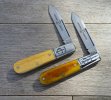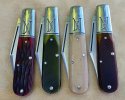Ironbut
Gold Member
- Joined
- Mar 1, 2016
- Messages
- 8,535
Good job, we can't let our wives get too comfortable. My wife has grown used to me watching TV with a GEC on the end table and a shotgun on my lap, the poor thing.
Sounds kinda' familiar. When I come in the house for the night, I take off my handgun & lay it on the end table beside my chair, and I'm usually fiddling with a knife doing something.
Years ago whenever I bought a new gun or knife, my wife would say, "What did that cost?" Or "How many of them do you need?" Now she just wants to know how much she can get for it when I die.






